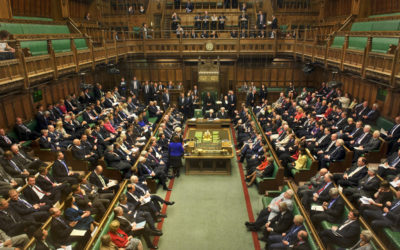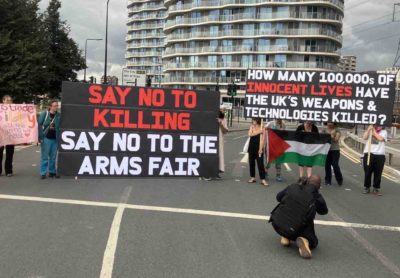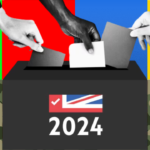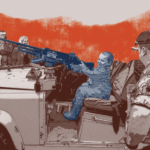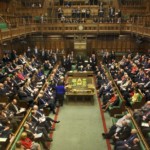Soldiers of the Future?
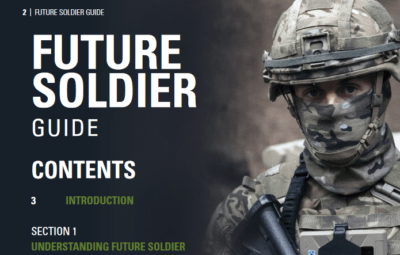
In March 2021, the MoD released its Defence Command Paper as part of the British Government’s wide ranging Integrated Review. Of the three services, the Army had perhaps the most attention and contributed to the process by releasing a 16-page briefing called Future Soldier outlining how it planned to respond to modernisation targets from the MoD. Ostensibly an internal facing doctrine aimed at civil servants and politicians it became the basis for a public facing – and much longer – Future Soldier Guide released eight-months later.
ForcesWatch have analysed the two documents to unpack these major proposals for the new-look British Army. It’s apparent that certain elements are updated iterations of processes already in motion: the new line on military diversity; the military’s claims of an environmental commitment; and increased integration of the military and private sector.
It also includes newer developments from the past 12 months, adding to our knowledge on the Ranger Regiments announced in the Command Paper and giving fresh insight on the incorporation of robotics and autonomous systems. There is also strong emphasis on the military’s planned role in shoring up the Union and the themes of sub-threshold warfare and Whole Force Approach dovetail with a desire to further integrate and expand the Reserves.
Our analysis shows that Future Soldier presents a number of contradictions, not least between the compulsion to modernise culturally and the military’s urge to cling to its conservatism. A similar process is underway on climate change: senior figures want the kudos of a greener brand, but are struggling to prioritise it meaningfully. The Army is also positioning itself as being in line with – and, in fact, central to – the UK’s modern democratic national identity, while at the same time gathering more and more units under an umbrella of secrecy that escapes parliamentary scrutiny. It is that problem we turn to first.
Ranger Units
In the weeks after the Future Soldier Guide was released, Forces Watch warned about the democratic implications of removing particular military units from Parliamentary accountability. Of chief concern is that special forces regiments – and an increasing number of quasi-special forces units – are folded under a “special” heading which makes their activities opaque. Such units are impervious to Freedom of Information requests and subject to a Parliamentary convention in which “no comment” is the standard response to questions put by MPs in the Commons.
As we outlined back in December, the new Ranger battalions – modelled on the US special forces of the same name – will expand the Army units operating outside the confines of democratic oversight and are a crucial element of the Future Soldier transformations. The four battalions will be contained within 6th (United Kingdom) Brigade alongside a squadron of Royal Signals soldiers providing ‘communication and information support’. The Battalions themselves are numbered one to four and will be located in Belfast (1 RR), Aldershot (2 & 4 RR) and Pirbright (3 RR). The 3rd Battalion will join 2nd and 4th in Aldershot by 2027.
One of the Ranger’s key roles will be preparing allied forces:
‘The Ranger Regiment provides the foundation for the Army Spec Ops Bde, operating at the vanguard of expeditionary posture in austere and hostile environments. This involves deterring adversaries and contributing to collective deterrence by training, advising and if necessary accompanying partners in support of national interests.’
An example of this kind of operation is already underway. A group of Rangers have deployed to Ukraine amid the tensions with Russia, accompanied by a number of infantry-operated missile systems on which they will deliver training to local forces.
It is worth noting, however, that the Defence Secretary Ben Wallace seems to envision the Rangers as operating outside NATO or NATO-type operations (Ukraine is not a member but clearly the current tensions centrally involve NATO). Questioned in November by the SNP’s Douglas Chapman, during a Common’s debate on Future Soldier, Wallace said:
‘On the Rangers, we envisage that a large proportion of their time will not necessarily be spent with NATO allies. They may be in Africa, the middle east or further afield. We have already started spending the money to equip them to be, if necessary, more independent. The reason that they are partly special is that they will often have to deploy without the usual huge amount of logistical support that a normal conventional unit gets, so they will have to be effectively a more selected cadre of people with better equipment to be able to be more independent and more 360 in their integration.’
This seems to invoke a more expeditionary force, which is in keeping with the Future Soldier doctrine of a ‘ modern expeditionary Army for a Global Britain’ which can provide an “agile”, “persistent” presence – including via Britain’s existing network of overseas bases. Belize, Brunei and Kenya are among the countries mentioned as potential platforms for these missions.
Environmental Militarism
Whilst the Integrated Review covered climate change at length the Future Soldier documents mention little on the issue – the word climate only appears in the November document and is used just three times. However, the UK military both acknowledges, and is preparing for, climate change and the spectre of environmental catastrophe stalks the proposals. As the Future Soldier Guide posits:
‘Climate change forces us to question some of our most basic assumptions about how we operate. Key to this is understanding the impacts on our people and our equipment, and working to preserve our freedom of manoeuvre. And so, for the British Army to succeed it must transform radically: its culture, its technology and how it fights.’
As with the Ranger units, the Guide explains that within this context of environmental turbulence Future Soldier is meant to enhance the Army’s ‘ability to compete – all of the time’:
‘We will have a persistent global presence and engage with allies and partners in responding to emerging threats. When we are required to fight, it is our readiness and ability to respond rapidly that will be decisive.’
This position follows the framework ForcesWatch have previously outlined: the military’s primary concern is how to exploit the opportunity and adapt militarily, rather than stopping environmental collapse. There is no suggestion that the Army intends to do anything other than re-calibrate strategy and tactics to fit the security challenges of climate change and ensure it is able to operate in environmentally hostile battlescapes or times of fuel shortages. This is perfectly illustrated in a brief outline of Project Mercury, in what is the only other example of climate-related thinking in Future Soldier:
‘Under a project called MERCURY, the Army is looking forward to the capabilities required in 2035 and beyond, leveraging the lower carbon technologies of the future to enhance our operational and strategic advantage.’
A recent piece on Forces TV had Army sustainability lead General Richard Nugee explaining the military’s environmental rationale from the Antarctic. The interview came in the midst of a 9000 mile trip:
‘Those who say the MOD are big emitters, yes we are. Those who say the MOD shouldn’t be getting involved in climate security, I would fundamentally disagree.’
Nugee cites hurricanes in the Caribbean and farmers joining ISIS to support his thesis, before adding in figures on high wartime casualties among logistics personnel in recent wars:
‘The US military estimates it lost between two and 3,000 troops on logistic re-supply in Iraq and Afghanistan. We lost our most senior officer, a lieutenant colonel.’
He continues:
‘If you can find a way of reducing the amount of logistic support that you need by thinking about sustainability, thinking about producing your own energy and water, then you’re saving lives at the same time.’
Beneath these garbled interventions it is possible to discern that the military is struggling to formulate convincing ‘green’ credentials given the demands of warfighting. In merely paying lip-service to climate change, Future Soldier demonstrates that the Army’s biggest concern is focused on the implications for operational effectiveness.
Intersectional Militarism
‘There’s nothing politically correct or woke about it’, Chief of the General Staff (CGS) Mark Carleton-Smith insists in the Future Soldier Guide. This can be read in any number of ways, but the CGS’ comments suggest an acute tension between the military’s grudging attempts to modernise and its natural institutional conservatism.
Carleton-Smith’s full quote runs:
‘Today in the Army it’s not just the outcome that’s important. It’s increasingly the manner in which that outcome is achieved; this is about common decency and courtesy. It’s about mutual respect, and the moral courage to do not just the right thing, but the best thing, and not to tolerate anything less. There’s nothing politically correct or woke about it. It’s about improving how we treat each other and how we behave around one another.’
The text that follows his quote takes on a corporate tone:
‘The Army is its people. People are our most adaptive, resilient, and inherently competitive capability – and our people will continue to be the Army’s competitive edge, prepared to win in the digital age. Maximising the potential of every individual in the Army will be critical to our success, as will be the creation of a culture where everyone is comfortable and empowered to perform to their very best.
Over the next decade the Army’s workforce (Regular, Reserve and Civilian), will modernise, transform, re-size and re-shape. The Army must have the right people with the right skills, and its culture must be one that underwrites the Army’s operational effectiveness.’
This fits closely with new Chief of the Defence Staff Admiral Tony Radakin’s first speech at the Royal United Services Institute (RUSI) in December 2021, during which he sought to address diversity while straining out any notions of “wokeness” – reintegrating it as a common-sense component in operational effectiveness. ‘This is not about wokefulness’, he claimed:
‘It is about woefulness. The woefulness of too few women. The woefulness of not reflecting the ethnic, religious and cognitive diversity of our nation. And the woefulness of not following our own values, whether respect for each other or the simple integrity of claiming expenses. This affects our culture, our fighting power, our prowess.’
There are questions around who is being addressed here. Certainly one audience is external: the general public, NGOs, politicians, the media. Groups whose support must be recruited constantly. But probably also an internal audience: the old guard of officers and NCOs – and perhaps also ex-military figures and civilian conservatives in business, Parliament and the commentariat – to whom any suggestion of even a limited, liberal kind of equality within the military collides with an ingrained Hobbesian worldview.
Despite Radakin’s lament, our recent analysis of the Government’s response to gendered violence during the 2021 passage of the Armed Forces Bill highlights the military’s problems when it comes to ensuring justice for female personnel. Which begs the question: will the proposals in Future Soldier be able to tackle the seemingly ingrained institutional sexism permeating the armed forces?
The Cyborg Army
Much is made of the need to respond to technological changes and modernise as a fighting force. To do this, Future Soldier states that the Army will invest heavily in research and innovation. Interestingly, responsibility for trialling the army’s robotics and autonomous systems (RAS) has been handed to a non-elite infantry battalion. According to the Army website, 2nd Battalion, The Yorkshire Regiment used a stand at the DSEI arms fair in September to showcase the new capabilities that led to its unique designation as an Enhanced Light Force Battalion. The Cyprus-based unit will have £120m in new kit and technology to experiment with.
The Army article lays out some of the general tasks which will fall to 2 Yorks:
‘Examples of how the Army may deploy RAS in the future include autonomous systems to provide situational awareness or counter-drone capabilities; delivery of supplies to remote regions; and using AI to enhance the military decision-making process.’
It seems the Enhanced Light Force Battalion will be a laboratory for the Army’s technological advancement plans, and a new Experimentations and Trials Group, built around the work of the Yorkshire Regiment unit, will be established in early 2022. These are integral elements of Future Soldier’s wider pledge to modernise the Army’s capabilities ‘such as tanks and long-range artillery’ while exploiting ‘emerging technology, realising the benefits of digitisation to make these capabilities more lethal’. Here, digitisation includes automation, machine learning and artificial intelligence alongside ‘electromagnetic activities’.
The Union, Industry and War
Future Soldier includes an attempt to define – or redefine – the military’s relationship with the Union. ‘Strengthening the United Kingdom’, as one section under a picture of proud soldiers claims, and a ‘physical embodiment of the Union’. While not exactly ‘blood and soil’, it is boldly ideological and openly militarist. This is accompanied by assertions about the different ways the Army is integral to the nation: well-worn claims about the service as an engine of social mobility and the role of the armed forces in different aspects of national emergency response. The latter includes mention of a military role in “homeland” security, presumably in support of terrorism response (the accompanying image shows a soldier and a police officer standing together).
A new Army Land Industrial Strategy is also woven into the Future Soldier vision:
‘The Army will continue to ‘level-up’ society, both as an agent of social mobility, and by boosting the economy where we are based and where we invest.’
By extension, defence firms are set to benefit from the economic ‘boost’ it provides with new opportunities outside of the traditional focus on shipbuilding, aerospace and so-called complex weapons systems. Yet, whilst there is much emphasis on unlocking innovation for land-based hardware, the health repercussions for soldiers of the £5.5 billion Ajax armoured vehicle programme should serve as a reminder of how industry can cause major problems for the Army.
There is also emphasis on the Whole Force as a combining of the military, private contractors and the civil service. The strategy promises £2bn in military research and development funding and forecasts that this will help produce an extra £6bn in what appears to be overseas arms and defence equipment sales. Supposedly, this will double the UK’s share in a £45bn “addressable” global market. This process will be substantially green, it is claimed
‘…a catalyst for a lower carbon footprint, pioneering the development of ‘green’ technologies, to significantly reduce carbon emissions from land capabilities and contribute to the Army achieving ‘net carbon zero 50’.’
Focus on the Army’s ability to generate exports should be seen as part of the wider role carved out for Defence in the post-Brexit model of ‘Global Britain’. It is claimed 10,000 jobs will be created as part of this process, with another 10,000 jobs ‘boosted’ indirectly.
The Whole Force concept also focuses on restructuring and integration, in which a reduced regular Army will be strengthened by an expanded Reserves alongside the deeper connections with the civil service and private sector. Key to this process is the Army Reserve Transformation Programme, which not only aims to ensure they contribute to operations but also provide ‘industry with resilient leaders and individuals’ with changes to the management of the Reserve ‘to ensure that employers are not adversely affected’.
Change or Contradictions?
Reading the Future Soldier materials, it is hard to escape the sense that the doctrine is trying to be all things to all people. It is alive with tensions and inconsistencies but perhaps this is to be expected when the underlying premise only truly accounts for two key elements: the Army’s modernisation as a fighting force and its ability to carve out a niche in Defence’s new role as a driver of economic prosperity in post-Brexit “Global Britain”. Shoehorning diversity and environmentalism into this paradigm simply creates the contradictions outlined above; afterall, a leopard cannot change its spots.
See more: legislation & policy, security, UK Parliament
Like what you read?
> Sign up for our newsletter or blog notifications
> Support our work – from just £2 a month

